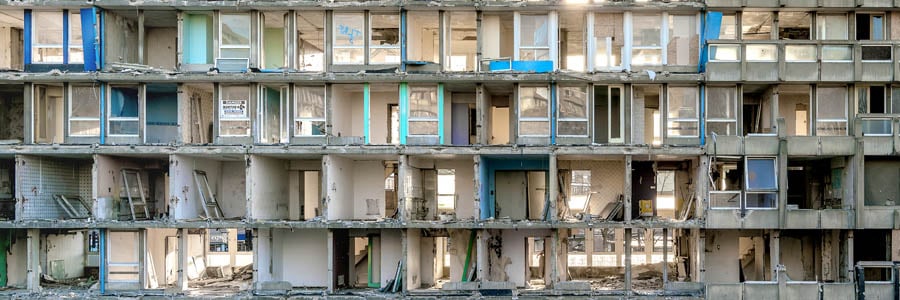
September 16, 2019
Chicago Architecture Biennial Preview: Housing
At the biennial, artists and activists shine a light on a tragic chapter of the 20th century—the rise and fall of public housing.
In the run-up to the Chicago Architecture Biennial 2019, which opens on 19 September, Metropolis presents a series of previews of the themes running through the event. For exhibitors at this year’s biennial, the “art” of building is hardly innocent. From resource management to property relations, these works reveal a more complex reality.

Courtesy © Do Ho Suh/Courtesy the artist, and Lehmann Maupinn, New York, Hong Kong, and Seoul, and Victoria Miro London/Venice, and Commissioned by The V&A
The forlorn brick redoubt at the corner of West Taylor and South Ada Streets in Chicago’s Little Italy neighborhood is the last remaining vestige of the Jane Addams Homes. When the complex opened in 1938, it was one of the city’s first public housing developments, its name paying homage to a key protagonist of America’s Progressive Era. Now its windows are boarded up and its perimeter has been fenced off, which makes the few feet separating the sidewalk and the front entrance appear yawning. And yet murmurs seem to emanate from within, street-bound, a chorale of voices forming an eerie broadcast.
This soundscape is one of the Chicago Architecture Biennial’s satellite installations, an experiential entry to an undertold chapter of American history in which the optimistic idea of public housing became public anathema. Produced by a pair of media practices, the local Stockyard Institute and the Johannesburg outfit Keleketla! Library, the aural work was partially assembled from recordings belonging to the National Public Housing Museum, which plans to repurpose the Jane Addams Homes for its exhibition and administrative use.
“One thing that we keep hearing over and over again is the sense of community that people were able to formulate,” says Mark Jaeschke, the museum’s project coordinator. “People who lived in these complexes still plan reunions to see their friends who’ve since been spread out across the city, the state, even the country.”
Jaeschke acknowledges that these narratives, while instructive, do not diminish the causes of public housing’s abandonment. Violent and nonviolent crime compounded the larger sins of neglect, segregationist policies, and cynical policing; architecture, hardly blameless, contributed to these ills, helping put a virtual end to federal housing programs.
Within the Chicago Cultural Center, another work offers a counterexample. South Korean artist Do Ho Suh presents an enthralling film about the Robin Hood Gardens housing estate in London, a notorious example of British public, or council, housing. Whereas Chicago’s largest housing complexes, like the baleful towers of the Robert Taylor Homes, were poorly conceived, value-engineered places to live, Robin Hood Gardens was a self-assured, outlandish statement about new ways of housing people. Compiled from still photographs and 3D scans taken ahead of the site’s demolition in 2018, Suh’s film is not merely content with the building’s aesthetic recuperation, capturing, too, the domestic side of this Brutalist colossus: His camera lingers on the personal artifacts and other chintzy trappings that make a house a home.
Like its Chicago counterparts, and many of its English kin, Robin Hood Gardens nonetheless failed, even when assessed on its own terms. “Architecture is useless on its own,” concludes Miguel Robles-Durán, founding member and director of the research nonprofit Cohabitation Strategies. At the biennial, Robles-Durán and his collaborators are formally launching Urban Front, a consultancy for progressive governments in the mold of McKinsey & Company, “but for the left.” Robles-Durán, who has consulted with municipalities from Caracas to Philadelphia, is lending his expertise to a proposal to redevelop Barcelona’s Fira fairground as a model for 21st-century urbanism. Housing is at the forefront of that vision, which will involve intervention on an order rarely seen since the heyday of the welfare state. But, Robles-Durán notes, the plan does not take its starting point from that outmoded, paternalistic model. Instead, “the direction is to create a knowledge-based education for people to come together and build their own housing. The government then becomes a liaison.”
You may also enjoy “Chicago Architecture Biennial Preview: Rights to Resources.“
Would you like to comment on this article? Send your thoughts to: [email protected]







